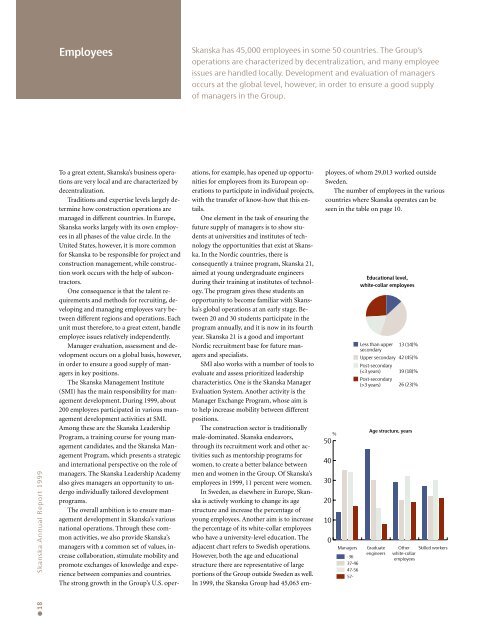Annual Report 1999 - Skanska
Annual Report 1999 - Skanska
Annual Report 1999 - Skanska
You also want an ePaper? Increase the reach of your titles
YUMPU automatically turns print PDFs into web optimized ePapers that Google loves.
Employees<strong>Skanska</strong> has 45,000 employees in some 50 countries. The Group’soperations are characterized by decentralization, and many employeeissues are handled locally. Development and evaluation of managersoccurs at the global level, however, in order to ensure a good supplyof managers in the Group.● 18 <strong>Skanska</strong> <strong>Annual</strong> <strong>Report</strong> <strong>1999</strong>To a great extent, <strong>Skanska</strong>’s business operationsare very local and are characterized bydecentralization.Traditions and expertise levels largely determinehow construction operations aremanaged in different countries. In Europe,<strong>Skanska</strong> works largely with its own employeesin all phases of the value circle. In theUnited States, however, it is more commonfor <strong>Skanska</strong> to be responsible for project andconstruction management, while constructionwork occurs with the help of subcontractors.One consequence is that the talent requirementsand methods for recruiting, developingand managing employees vary betweendifferent regions and operations. Eachunit must therefore, to a great extent, handleemployee issues relatively independently.Manager evaluation, assessment and developmentoccurs on a global basis, however,in order to ensure a good supply of managersin key positions.The <strong>Skanska</strong> Management Institute(SMI) has the main responsibility for managementdevelopment. During <strong>1999</strong>, about200 employees participated in various managementdevelopment activities at SMI.Among these are the <strong>Skanska</strong> LeadershipProgram, a training course for young managementcandidates, and the <strong>Skanska</strong> ManagementProgram, which presents a strategicand international perspective on the role ofmanagers. The <strong>Skanska</strong> Leadership Academyalso gives managers an opportunity to undergoindividually tailored developmentprograms.The overall ambition is to ensure managementdevelopment in <strong>Skanska</strong>’s variousnational operations. Through these commonactivities, we also provide <strong>Skanska</strong>’smanagers with a common set of values, increasecollaboration, stimulate mobility andpromote exchanges of knowledge and experiencebetween companies and countries.The strong growth in the Group’s U.S. operations,for example, has opened up opportunitiesfor employees from its European operationsto participate in individual projects,with the transfer of know-how that this entails.One element in the task of ensuring thefuture supply of managers is to show studentsat universities and institutes of technologythe opportunities that exist at <strong>Skanska</strong>.In the Nordic countries, there isconsequently a trainee program, <strong>Skanska</strong> 21,aimed at young undergraduate engineersduring their training at institutes of technology.The program gives these students anopportunity to become familiar with <strong>Skanska</strong>’sglobal operations at an early stage. Between20 and 30 students participate in theprogram annually, and it is now in its fourthyear. <strong>Skanska</strong> 21 is a good and importantNordic recruitment base for future managersand specialists.SMI also works with a number of tools toevaluate and assess prioritized leadershipcharacteristics. One is the <strong>Skanska</strong> ManagerEvaluation System. Another activity is theManager Exchange Program, whose aim isto help increase mobility between differentpositions.The construction sector is traditionallymale-dominated. <strong>Skanska</strong> endeavors,through its recruitment work and other activitiessuch as mentorship programs forwomen, to create a better balance betweenmen and women in the Group. Of <strong>Skanska</strong>’semployees in <strong>1999</strong>, 11 percent were women.In Sweden, as elsewhere in Europe, <strong>Skanska</strong>is actively working to change its agestructure and increase the percentage ofyoung employees. Another aim is to increasethe percentage of its white-collar employeeswho have a university-level education. Theadjacent chart refers to Swedish operations.However, both the age and educationalstructure there are representative of largeportions of the Group outside Sweden as well.In <strong>1999</strong>, the <strong>Skanska</strong> Group had 45,063 em-ployees, of whom 29,013 worked outsideSweden.The number of employees in the variouscountries where <strong>Skanska</strong> operates can beseen in the table on page 10.50403020100%Managers-3637-4647-5657-Educational level,white-collar employeesLess than uppersecondary13 (14)%Upper secondary 42 (45)%Post-secondary(3 years) 26 (23)%Age structure, yearsGraduateengineersOtherwhite-collaremployeesSkilled workers
















